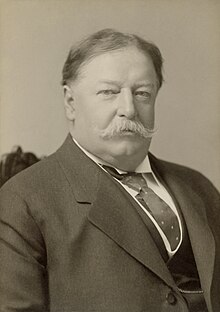William Howard Taft | |
|---|---|
Portrait, c. 1908 | |
| 27th President of the United States | |
| In office March 4, 1909 – March 4, 1913 | |
| Vice President |
|
| Preceded by | Theodore Roosevelt |
| Succeeded by | Woodrow Wilson |
| 10th Chief Justice of the United States | |
| In office July 11, 1921 – February 3, 1930 | |
| Nominated by | Warren G. Harding |
| Preceded by | Edward Douglass White |
| Succeeded by | Charles Evans Hughes |
| 42nd United States Secretary of War | |
| In office February 1, 1904 – June 30, 1908 | |
| President | Theodore Roosevelt |
| Preceded by | Elihu Root |
| Succeeded by | Luke Edward Wright |
| 1st Provisional Governor of Cuba | |
| In office September 29, 1906 – October 13, 1906 | |
| Appointed by | Theodore Roosevelt |
| Preceded by | Tomás Estrada Palma (as President) |
| Succeeded by | Charles Edward Magoon |
| Governor-General of the Philippines | |
| In office March 16, 1900 – December 23, 1903 | |
| Appointed by | William McKinley |
| Preceded by | Jacob Gould Schurman (as Chairman of the First Philippine Commission) |
| Succeeded by | Luke Edward Wright |
| Judge of the United States Court of Appeals for the Sixth Circuit | |
| In office March 17, 1892 – March 15, 1900 | |
| Appointed by | Benjamin Harrison |
| Preceded by | Seat established |
| Succeeded by | Henry Franklin Severens |
| 6th Solicitor General of the United States | |
| In office February 4, 1890 – March 20, 1892[1] | |
| President | Benjamin Harrison |
| Preceded by | Orlow W. Chapman |
| Succeeded by | Charles H. Aldrich |
| Personal details | |
| Born | September 15, 1857 Cincinnati, Ohio, U.S. |
| Died | March 8, 1930 (aged 72) Washington, D.C., U.S. |
| Resting place | Arlington National Cemetery |
| Political party | Republican |
| Spouse | |
| Children | |
| Parents | |
| Relatives | Taft family |
| Education | |
| Occupation |
|
| Signature | |
| ||
|---|---|---|
|
27th President of the United States
Presidential campaigns
10th Chief Justice of the United States
Post-presidency
 |
||
| This article is part of a series on |
| Conservatism in the United States |
|---|
 |
William Howard Taft (September 15, 1857 – March 8, 1930) was the 27th president of the United States and the tenth chief justice of the United States, the only person to have held both offices. Taft was elected president in 1908 as a Republican and was defeated for reelection in 1912 by Democratic nominee Woodrow Wilson. In 1921, President Warren G. Harding appointed Taft to be chief justice, a position he held until 1930.
Taft was born in Cincinnati, Ohio. His father, Alphonso Taft, was a U.S. attorney general and secretary of war. Taft attended Yale and joined Skull and Bones, of which his father was a founding member. After becoming a lawyer, Taft was appointed a judge while still in his twenties. He continued a rapid rise, being named solicitor general and a judge of the Sixth Circuit Court of Appeals. In 1901, President William McKinley appointed Taft civilian governor of the Philippines. In 1904, President Theodore Roosevelt made him Secretary of War, and he became Roosevelt's hand-picked successor. Despite his personal ambition to become chief justice, Taft declined repeated offers of appointment to the Supreme Court of the United States, believing his political work to be more important.
With Roosevelt's help, Taft had little opposition for the Republican nomination for president in 1908 and easily defeated William Jennings Bryan for the presidency in that November's election. In the White House, he focused on East Asia more than European affairs and repeatedly intervened to prop up or remove Latin American governments. Taft sought reductions to trade tariffs, then a major source of governmental income, but the resulting bill was heavily influenced by special interests. His administration was filled with conflict between the Republican Party's conservative wing, with which Taft often sympathized, and its progressive wing, toward which Roosevelt moved more and more. Controversies over conservation and antitrust cases filed by the Taft administration served to further separate the two men. Roosevelt challenged Taft for renomination in 1912. Taft used his control of the party machinery to gain a bare majority of delegates and Roosevelt bolted the party. The split left Taft with little chance of reelection, and he took only Utah and Vermont in Wilson's victory.
After leaving office, Taft returned to Yale as a professor, continuing his political activity and working against war through the League to Enforce Peace. In 1921, Harding appointed Taft chief justice, an office he had long sought. Chief Justice Taft was a conservative on business issues, and under him there were advances in individual rights. In poor health, he resigned in February 1930, and died the following month. He was buried at Arlington National Cemetery, the first president and first Supreme Court justice to be interred there. Taft is generally listed near the middle in historians' rankings of U.S. presidents.
Cite error: There are <ref group=lower-alpha> tags or {{efn}} templates on this page, but the references will not show without a {{reflist|group=lower-alpha}} template or {{notelist}} template (see the help page).
- ^ Jost, Kenneth (1993). The Supreme Court A to Z. CQ Press. p. 428. ISBN 9781608717446. Archived from the original on December 14, 2020. Retrieved January 2, 2019.

